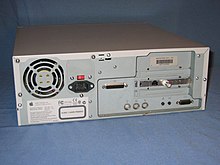 The Power Macintosh 7220/200 | |
| Developer | Apple Computer, Inc. |
|---|---|
| Product family | Power Macintosh |
| Type | Desktop |
| Release date | November 7, 1996 |
| Introductory price | US$1,725 (equivalent to $3,351 in 2023) |
| Discontinued | February 1998 |
| Operating system | System 7.5.3 - Mac OS 9.1 |
| CPU | PowerPC 603e @ 160 and 200 MHz |
| Memory | Expandable to 160 MB (70 ns 168-pin DIMM) |
| Successor | Power Macintosh G3 Desktop |
The Power Macintosh 4400 (sold as the Power Macintosh 7220 in some markets) is a personal computer designed, manufactured and sold by Apple Computer, Inc. from November 1996 to February 1998. It differs from prior desktop Macintosh models in that it was built with industry-standard components such as an IDE hard drive and an ATX-like power supply.
The 4400 was introduced to the market at a time when several Macintosh clones were available on the market, often at prices lower than Apple's. The "Tanzania" logic board in the 4400 was an Apple design but had only been used in clones up to this point. MacWEEK's review described the case as "Strange in the Apple brood; when compared with PCs it fits right in with the flock. It is contained in a stock desktop PC case fitted with Apple's distinctive curved nose piece. The back is industrial-looking, while bent sheet metal fills the case's insides, sharp edges and all. The IDE drive sits on end, while the Comm II slot (occupied with an Ethernet card) and two PCI slots reside in a riser card. For the first time, Apple has abandoned automatic switching in the power supply, a small cost savings at the expense of international users' convenience."[1]
This was the only Power Macintosh to be designed with the goal of using low-cost manufacturing techniques; the 4400 was removed from Apple's lineup a few months after the Power Macintosh G3 Desktop went on sale, which was priced comparably to the 4400 but used Apple's Power Macintosh 7300 form factor instead.[citation needed]


